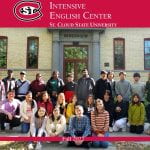The Student Visa (F-1) Process
By: Paripa Michelle Ganou
Studying in the US as an international student may seem like a complicated and overwhelming process. There are many details you must know when planning to study abroad. However, thousands of students successfully study in the United States each year. As an international student myself, I successfully applied to the Intensive English Center and obtained an F-1 student visa. The most important steps to studying in the U.S. are applying to an academic program and applying for a student visa. I hope to demystify the process for you today.
First, you must apply for admission to a Student and Exchange Visitor Program (SEVP)-approved school. To search for a school, look for colleges or universities in locations of interest, where friends may study, by programs of interest, and cost per year. These are important factors to consider. You may confirm if the school is SEVP certified using this search tool: https://studyinthestates.dhs.gov/school-search. If you are planning to study full-time in a program in the U.S., you will most likely seek an F-1 International Student Visa. Students with an F-1 visa enroll in language training programs (such as the IEC) or degree programs.
I chose the Intensive English Center, but I also had conditional admission to a graduate program at another Minnesota university. Each school has different admission criteria. Make sure that you meet the requirements and submit all necessary documents. Speak with an admissions representative if you have any questions about the school’s application process. It is important to apply well in advance so that you have time to complete the visa process before your program begins.
If admitted, the school will issue you a Form I-20 (if seeking an F-1 visa). This is an official document that confirms you have been admitted to your program and that you are now eligible to apply for a student visa. It is important to understand that admission to a U.S. school and obtaining an I-20 does not guarantee that you will receive a visa. Next, pay the Student and Exchange Visitor Information System (SEVIS) I-901 Fee upon receiving your I-20. The SEVIS system tracks students and exchange visitors. You will be registered in this system as an international student. This is not the same as your visa application fee.
After that step, you may begin the visa application process. The visa application and interview is often the most challenging step in studying abroad. It is not uncommon for visa applications to be denied. Depending on your home country, the ability to get a U.S. visa may be even more difficult. It is important to pay close attention to the visa application procedures for your country and be well-prepared for your visa interview. In general, the visa process follows these steps:
- Complete the online Nonimmigrant visa application (Form DS-160). Print the application form confirmation page for your interview.
- Upload a photo to your online Form DS-160. There are specific photograph requirements.
- Pay the non-refundable visa application fee.
- Schedule an interview.
- Gather required documents before your interview. Documents may include your passport, Form DS-160, application fee payment receipt, photo, and I-20. Other documents such as academic documents and financial statements may be required.
- Attend your visa interview. The embassy or consular official makes the final decision if you will receive an F-1 visa.
The visa process may vary depending on the U.S. embassy or consulate. Check with your embassy or consulate for specific instructions.
During the visa interview, the official will ask you questions pertaining to your studies, goals, and personal life. When I did my visa interview, the officer asked me the following questions:
“What are you going to do in the US?”
“Would you come back to your country?”
“Do you have family in the U.S.?”
“Who will be your sponsor?”
“What are you going to study?”
I was nervous during my interview, but I knew it was best to answer the questions honestly. My other advice is to give short answers that are to the point. Your visa interview will be short. I suggest you read St. Cloud State University’s Top 10 Tips for Nonimmigrant Visa Interviews.
If your visa is denied, you may ask for a written reason. You may re-apply if you are able to correct the issue. It is usually best to ask your school to defer your admission to a future semester for more time. If you are issued a visa, you may start preparing your travel arrangements. International students may enter the US with an F-1 visa up to 30 days before your program start date (on the I-20). Please note that a visa does not guarantee entry to the U.S. You must still get approval from the U.S. Customs and Board Protection (CBP) officials at your port-of-entry. Make sure that you have all of your documents ready when traveling: I-20, passport, and visa. You must arrive to your school by the program start date. They may require your attendance at a new student orientation.
Personally, as an international student, I was stressed about the visa process. I had no idea how to proceed. Thankfully, I received help from someone who had experience. I suggest that you reach out to other international students who have been through the process. Some international students are able to work with an education abroad agency to prepare the visa paperwork as well. We hope that you found the information in this article to be helpful. And, don’t forget, your school’s staff are available to answer any questions you may have.

















Thanks for the information.. mybkexperience
Thanks for the information. mybkexperience